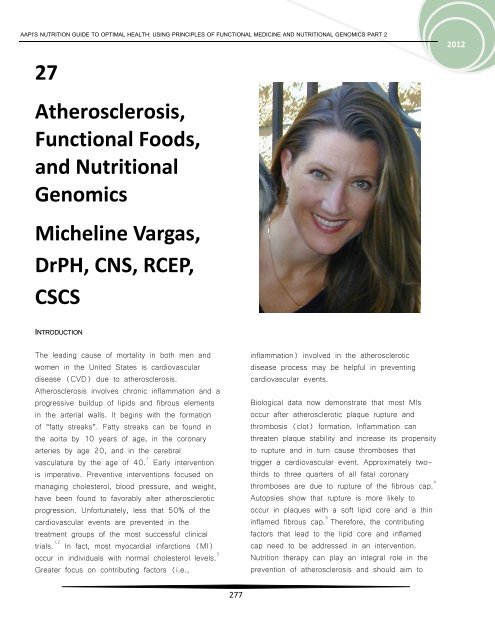optimal health: functional medicine and nutritional genomics
optimal health: functional medicine and nutritional genomics
optimal health: functional medicine and nutritional genomics
You also want an ePaper? Increase the reach of your titles
YUMPU automatically turns print PDFs into web optimized ePapers that Google loves.
AAPI’S NUTRITION GUIDE TO OPTIMAL HEALTH: USING PRINCIPLES OF FUNCTIONAL MEDICINE AND NUTRITIONAL GENOMICS PART 2<br />
27<br />
Atherosclerosis,<br />
Functional Foods,<br />
<strong>and</strong> Nutritional<br />
Genomics<br />
Micheline Vargas,<br />
DrPH, CNS, RCEP,<br />
CSCS<br />
2012<br />
INTRODUCTION<br />
The leading cause of mortality in both men <strong>and</strong><br />
women in the United States is cardiovascular<br />
disease (CVD) due to atherosclerosis.<br />
Atherosclerosis involves chronic inflammation <strong>and</strong> a<br />
progressive buildup of lipids <strong>and</strong> fibrous elements<br />
in the arterial walls. It begins with the formation<br />
of “fatty streaks”. Fatty streaks can be found in<br />
the aorta by 10 years of age, in the coronary<br />
arteries by age 20, <strong>and</strong> in the cerebral<br />
vasculature by the age of 40. 1<br />
Early intervention<br />
is imperative. Preventive interventions focused on<br />
managing cholesterol, blood pressure, <strong>and</strong> weight,<br />
have been found to favorably alter atherosclerotic<br />
progression. Unfortunately, less that 50% of the<br />
cardiovascular events are prevented in the<br />
treatment groups of the most successful clinical<br />
trials. 1,2<br />
In fact, most myocardial infarctions (MI)<br />
occur in individuals with normal cholesterol levels. 3<br />
Greater focus on contributing factors (i.e.,<br />
inflammation) involved in the atherosclerotic<br />
disease process may be helpful in preventing<br />
cardiovascular events.<br />
Biological data now demonstrate that most MIs<br />
occur after atherosclerotic plaque rupture <strong>and</strong><br />
thrombosis (clot) formation. Inflammation can<br />
threaten plaque stability <strong>and</strong> increase its propensity<br />
to rupture <strong>and</strong> in turn cause thromboses that<br />
trigger a cardiovascular event. Approximately twothirds<br />
to three quarters of all fatal coronary<br />
thromboses are due to rupture of the fibrous cap. 4<br />
Autopsies show that rupture is more likely to<br />
occur in plaques with a soft lipid core <strong>and</strong> a thin<br />
inflamed fibrous cap. 5 Therefore, the contributing<br />
factors that lead to the lipid core <strong>and</strong> inflamed<br />
cap need to be addressed in an intervention.<br />
Nutrition therapy can play an integral role in the<br />
prevention of atherosclerosis <strong>and</strong> should aim to<br />
277
















